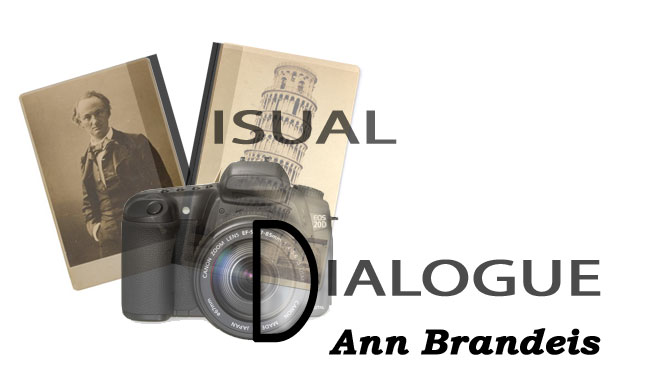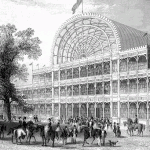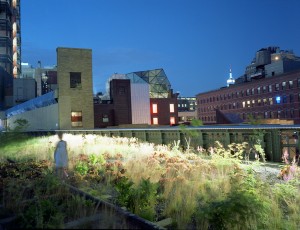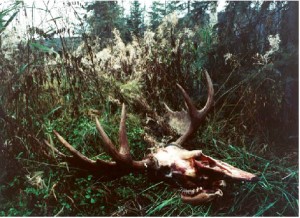Visual Dialogue

This month marks the 159th anniversary of “The Great Exhibition of the Works of Industry of All Nations.” Held in London in 1851, the Crystal Palace was host to what could be considered the first International Photographic Contest. The photographic medium was so new that the terms photograph, positive, and negative required explanations comprehensive explanations in the exhibition catalogue. Over 700 photographs were on display, and having no precedent, placing them within the exhibition proved controversial, some were placed in Class X with musical and scientific instruments, while others were shown in the Fine Arts section. Visited by over 6 million people, the submitted calotypes, daguerrotypes,  stereographs, and wet plate photographs vied for the public’s attention. The exhibition presented the work of British, French, Continental European, and American artists, who competed against each other for special awards. The American artist, Matthew Brady, proprietor of a prominent portrait studio in N.Y.C. (as well as the controversial Civil War Photographs stamped with his studio name), presented 46 daguerreotypes, which were recognized as the best in the show. Mr. Brady walked away with a multitude of awards.
stereographs, and wet plate photographs vied for the public’s attention. The exhibition presented the work of British, French, Continental European, and American artists, who competed against each other for special awards. The American artist, Matthew Brady, proprietor of a prominent portrait studio in N.Y.C. (as well as the controversial Civil War Photographs stamped with his studio name), presented 46 daguerreotypes, which were recognized as the best in the show. Mr. Brady walked away with a multitude of awards.
And now, 156 years later photographic technology and innovative artistic techniques still vie for attention at expo’s, galleries, and in the latest technological advancement, the on line ‘e-gallery.’
The sheer number of modern photography contests are astonishing. From multiple ‘calls for entry’ you can show your work in California, Texas, Alaska, Prague, Paris, and nearly anywhere else in the world the magic internet can reach. Nearly all don’t require the arduous and probably cholera ridden trip via steam ship to Hyde Park, London, but rather a few smart keystrokes and some deft mouse operation. Many of these contests, are found through internet listings, as well as newsletters and organizations which guide you to these resources. Evaluating the “Call for Entry” is essential, are they for real? Which one will really showcase our work? Are regional calls worth the expenditure? Exposure and feedback, are what we, as artists, require in order to evolve. Listed below some resource tools to help you get a firmer grasp on what is needed to take advantage of the new found competition. Resources will be a regular feature of this Blog, as each month new sources relevant to the discussion will be listed, and a large database of opportunities will be organized.
Some of the best forums for high quality submissions are: Art Show , Marketing Photos with Mary Virginia Swanson, PhotoBizGuru with Larry Padget, and Red Dog Journal (occasional erratic publication) , The last three are also filled with ideas to enhance skills and options.
The most prestigious organizations listing call for entry, with exhibition opportunities for ’emerging artists’ are The IPA Lucie Awards, PX3 Prix du Photographie du Paris, and the Photo Lucida awards (critical mass). Graphis magazine, Photo District News, Spyder Awards, LACADA, Photo Review, Center Santa Fe, C4FAP. are also high quality showcases, albeit expensive.
When evaluating opportunities there are other venues, which allow communication with artists, dealers, museum curators on a personal and professional level. They are infinitely more satisfying than simply submitting work, but they are quite competitive. The best known, and oldest of these organizations are FotoFest , Photolucida , and Review Santa Fe . Since FotoFest recently ended, a short summary of the events and happenings.
Every 2 years emerging artists from all over flock, like lemmings, to Houston Texas to participate in FotoFest. Joining all these hopefuls are some of the most influential leaders, gallery owners, museum directors. Most have their own agenda, looking to gain from the connections, find the new upcoming artist they can nurture or showcase. The brainchild of Wendy Watriss, Frederick Baldwin it celebrated it’s 13th Biennial this year. The hot ticket at FotoFest is the FotoReview at the Meeting Place, as photographers look to connect with reviewers hoping to make a contact, be noticed, get exhibited, or to simply gain from an expert’s opinion on their portfolio. This biennial event is comprised of 4 sessions, each session lasting 4 days, and all participants are assigned their session. From a published list they are asked to choose the 25 reviewers they would like the opportunity to see. In all fairness, the organizers of FotoFest try very hard to please all participants. But the event is not just about portfolio review, albeit, that is its driving force. This event is teeming with inspiring photo exhibitions, impressive lectures, and the electric and energized feeling one gets when spending time with other committed artists, talking about, what else, art.
EVAN MIRAPAUL in his insightful blog Fugitive Vision writes “Portfolio review is a funny animal. Both artist and reviewer come to the table with expectations and assumptions. Some of these are reasonable and helpful, and others are….well….something else…..and the sheer quantity of work being looked at boggles the mind”. “My philosophy about reviews is that the artist has paid a fee and deserves something back for that fee. Unless the artist specifically asks my opinion about the work, I usually restrict my comments to practical suggestions for career advancement and professional opportunities. That is what most of the artists have paid their fees to receive.”
Portfolio Review is not for the fragile, or faint of heart. The reviewers cycle through this, as well as the other fests, searching for the next “hit”, while the artists, also look for their connection with ego in hand, and for many this symbiotic relationship works. ’I survived FotoFest’ is an oft heard mantra.

Girl on Highline By Lynne Saville
A conversation with Lynn Saville, elicited the following comments from her experience at FotoFest. ”I had a lot of different reviewers. A friend had recommended that I show my new book “Night/Shift€ quickly and put it on my lap, then present my prints, so that the reviewers wouldn’t spend most of the precious twenty minute session slowly leafing through it. My friend also recommended I try not to show too many prints so there would be time – about 8 or 9 minutes to talk about possible shows acquisitions or other possibilities they might offer. The reviewers responded differently. My favorite reviewers were the curators at museums and the collectors. I was happy that a collector from Texas expressed an interest in a piece and immediately emailed me about acquiring a print. It was good to see some people I’ve corresponded with but never met…such as Barbara Tannenbaum of the Akron Museum of Art. This was her first opportunity to view my prints and book, and I feel that it’s possible she might include my work in a show, but I will have to follow up. Most of the time, I was able to control the presentation, but one reviewer grabbed my book after I briefly showed it to her and said ’May I PLEASE look at the BOOK?’ There was a variety in the responses to my work. Once in a while I met a reviewer who had ‘an agenda’ such as to submit to their festival or come to reviews in their city. Overall, the experience was extremely positive.”
An emerging artist from London, England, Ali Richards traveled to California to oversee the hanging of her exhibition at the Kala Gallery in Berkeley. Her next stop Houston, Texas to attend the Meeting Place at FotoFest. Although Ali had placed well in many photo contests,
it was no longer satisfying, and did not generate gallery exhibitions. At FotoFest, she hoped to find the right reviewer who would recognize and promote her talent. Her first few reviews were less than stellar. Trying to figure out what would work, she went into a secluded area at the Meeting Place, pulled out her images, edited, reorganized, and re-edited her portfolio. She then reduced the number of images to the ones which would show her ideas. “This time”, she said, “my review was brilliant. “I felt confident my work would speak for itself. My first reviewer shook me with her cutting remarks. I shouldn’t have let one bad review effect me. Talking with people made me feel confident and people were generous in sharing information.”
Mary Virginia Swanson, an insightful advocate of the artist/ photographer, publishes a wonderful piece on succeeding at portfolio review. Her blog, well read by those within the photo/art community, (www.mvswanson.com) and her understanding of the process and protocols of the art world has supported many well known artists. This is important if one wishes to join the frey, and sign up for photolucida, Photo Review at Woodstock, Review Santa Fe, or any of the newer photo review groups.
This startling rise in the organizations promoting photo reviews leads one to wonder if there more artists looking to be recognized in the art world, if this is the current trend for exhibition vetting, whether these events are a sound business enterprise filling in a gap while raising a decent amount of money, or organizations who desire to educate and promote the emerging artist. Probably all the above.
Henri Cartier Bresson: The Modern Century at MOMA (April 11-June 28) is exhilarating and overwhelming. Curated by Peter Galassi, Chief Curator of Photography at MOMA the show is divided into 13 sections, hung in 8 rooms, and contains 306 black and white photographs. His best known images from the 1930′s showcase his modernist approach. Filled with avant garde, and surrealist influences, the term ‘the decisive moment’ is well justified. The exhibition which spans the period between 1929 through 1989 is hung thematically, highlights his Magnum years, and shows his changing approach. His later work has a tighter photojournalist control, and though quite elegant, does not always have the original, experimental freshness of his early years. But the magnificence of the show and the quality of his work cannot be underrated. It is however, interesting to note that there are detractors, who find his work pedantic and cold. A quote from The New Yorker states: “The hallmark of Cartier-Bresson’s genius is less in what he photographed than in where he placed himself to photograph it, incorporating peculiarly eloquent backgrounds and surroundings. His shutter-click climaxes an artful scurry for the perfect point of view.” And the most often quoted line from the New Yorker article is by Robert Frank who stated: “He traveled all over the goddamned world, and you never felt that he was moved by something that was happening other than the beauty of it, or just the composition.€
AND in closing a brief mention of the topic from the latest symposium at SFMOMA, (San Francisco MOMA ) held on April 22 and April 23, 2010.
Is Photography Over?
http://www.sfmoma.org/pages/research_projects_photography_over
Next month, some of the best photo blogs will be reviewed, and additional info for the data base will be added. Current exhibitions, as well as the ideas behind conceptual photography, staged realism and artists working within this thematic construct.


